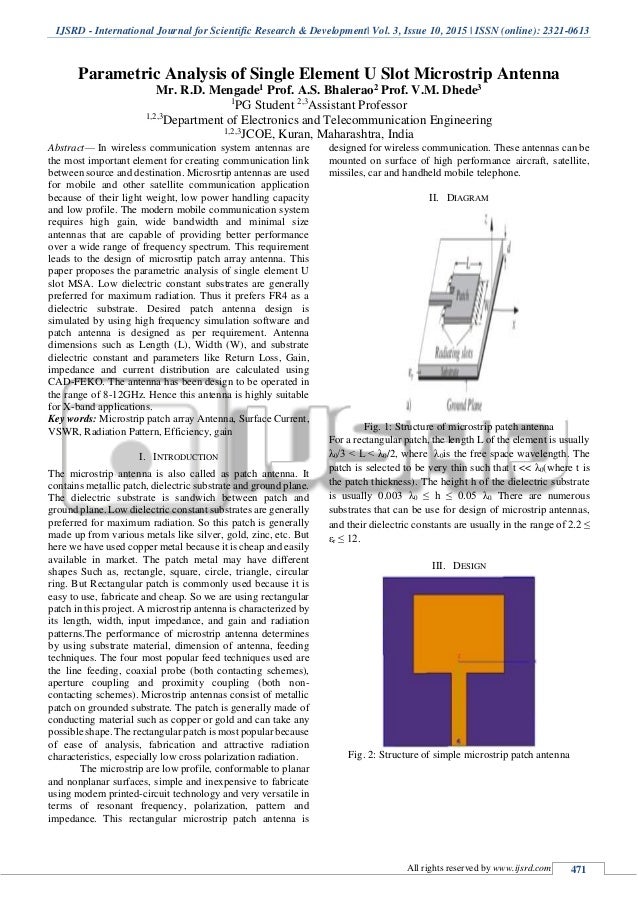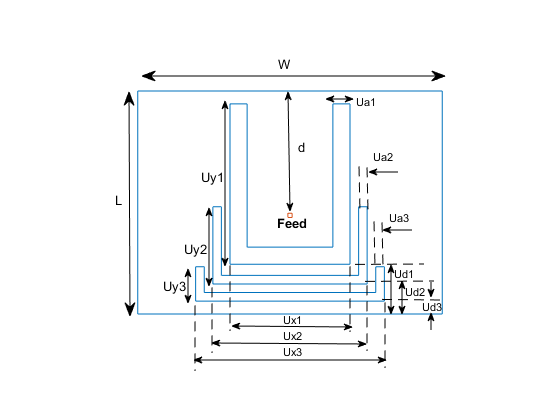- Slot Antenna Pdf
- Slot Antenna Design
- Patch Antenna Design Calculator
- Patch Antenna Design
- Circular Patch Antenna Design
- Slot Antenna For Hf
The U-slot patch antenna was originally developed as a single-layer, single-patch wideband antenna. It has recently been shown that it can also be designed to perform a number of other functions. To validate the design technique antenna is fabricated and measured results are compared with the simulated to assess the performance. In this dissertation, effect of reactive loading on probe fed, single layer, U-Slot loaded microstrip antenna is investigated using Theory of Characteristic Modes (TCM). Bandwidth with better vector impedance matching.The patch antenna has been designed and simulated using IE3D software.The wide band antenna resonates at 4.2 GHz and 5.5 GHz.For U-T slot wide band antenna the bandwidth is 2.11 GHz covers some of the band used for WLAN and WiMAX.So the proposed antenna can be used for WLAN and WiMAX. Patch antenna having pair of slits had achieved impedance bandwidth of 24% and peak gain of 7.2 dBi had reported in 1. A single U slot 2 has achieved impedance bandwidth upto 47% using thick probe, whereas double U slot using thick probe 3 it has achieved impedance bandwidth upto 44%. By using the method of stacking. The U-slot patch antenna was originally developed as a single-layer, single-patch wideband antenna. It has recently been shown that it can also be designed to perform a number of other functions.
A slot antenna consists of a metal surface, usually a flat plate, with one or more holes or slots cut out. When the plate is driven as an antenna by an applied radio frequency current, the slot radiates electromagnetic waves in a way similar to a dipole antenna. The shape and size of the slot, as well as the driving frequency, determine the radiation pattern. Slot antennas are usually used at UHF and microwave frequencies at which wavelengths are small enough that the plate and slot are conveniently small. At these frequencies, the radio waves are often conducted by a waveguide, and the antenna consists of slots in the waveguide; this is called a slotted waveguide antenna. Multiple slots act as a directivearray antenna and can emit a narrow fan-shaped beam of microwaves. They are used in standard laboratory microwave sources used for research, UHF television transmitting antennas, antennas on missiles and aircraft, sector antennas for cellular base stations, and particularly marine radar antennas. A slot antenna's main advantages are its size, design simplicity, and convenient adaptation to mass production using either waveguide or PC board technology.
Structure[edit]

As shown by H. G. Booker in 1946, from Babinet's principle in optics a slot in a metal plate or waveguide has the same radiation pattern as a driven rod antenna whose rod is the same shape as the slot, with the exception that the electric field and magnetic field directions are interchanged; the antenna is a magnetic dipole instead of an electric dipole; the magnetic field is parallel to the long axis of the slot and the electric field is perpendicular. Thus the radiation pattern of a slot can be calculated by the same well-known equations used for rod element antennas like the dipole. The waves are linearly polarized perpendicular to the slot axis. Slots up to a wavelength long have a single main lobe with maximum radiation perpendicular to the surface.

Antennas consisting of multiple parallel slots in a waveguide are widely used array antennas. They have a radiation pattern similar to a corresponding linear array of dipole antennas, with the exception that the slot can only radiate into the space on one side of the waveguide surface, 180° of the surrounding space. There are two widely used types:
- Longitudinal slotted waveguide antenna - The slots' axis is parallel to the axis of the waveguide. This has a radiation pattern similar to a collinear dipole antenna, and is usually mounted vertically. The radiation pattern is almost omnidirectional in the horizontal plane perpendicular to the antenna over the 180° azimuth in front of the slot, but narrow in the vertical plane, with the vertical gain increasing approximately 3 dB with each doubling of the number of slots. The radiation is horizontally polarized. It is used for vertical omnidirectional transmitting antennas for UHF television stations. For broadcasting, a cylindrical or semicircular waveguide is sometimes used with several columns of slots cut in different sides to give an omnidirectional 360° radiation pattern.
- Transverse slotted waveguide antenna - The slots are almost perpendicular to the axis of the waveguide but skewed at a small angle, with alternate slots skewed at opposite angles. This radiates a dipole pattern in the plane perpendicular to the antenna, and a very sharp beam in the plane of the antenna. Its largest use is for microwave marine radar antennas. The antenna is mounted horizontally on a mechanical drive that rotates the antenna about a vertical axis, scanning the antenna's vertical fan-shaped beam 360° around the water surface surrounding the ship out to the horizon with each revolution. The wide vertical spread of the beam ensures that even in bad weather when the ship and the antenna axis is being rocked over a wide angle by waves the radar beam will not miss the surface.
History[edit]
The slot antenna was invented in 1938 by Alan Blumlein, while working for EMI. He invented it in order to produce a practical type of antenna for VHF television broadcasting that would have horizontal polarization, an omnidirectional horizontal radiation pattern and a narrow vertical radiation pattern.[1][2]

Prior to its use in surface search radar, such systems used a parabolic segment reflector, or 'cheese antenna'. The slotted waveguide antenna was the result of collaborative radar research carried on by McGill University and the National Research Council of Canada during World War II.[3] The co-inventors, W.H. Watson and E.W. Guptill of McGill, were granted a United States patent for the device, described as a 'directive antenna for microwaves', in 1951.[4]
Other uses[edit]
In a related application, so-called leaky waveguides are also used in the determination of railcar positions in certain rapid transit applications. They are used primarily to determine the precise position of the train when it is being brought to a halt at a station, so that the doorway positions will align correctly with queuing points on the platform or with a second set of safety doors should such be provided.
See also[edit]
- Microwave Radiometer (Juno) (has a slot array antenna)
- RIMFAX (radar for Mars rover has slot antenna design)
References[edit]

- ^Blumlein, Alan (1938-03-07), 'Improvements in or relating to high frequency electrical conductors or radiators', British patent no. 515684
- ^Burns, Russell (2000). The life and times of A.D. Blumlein. Institution of Engineering and Technology. ISBN0-85296-773-X.
- ^Covington, Arthur E. (1991). 'Some recollections of the radio and electrical engineering division of the National Research Council of Canada, 1946-1977'. Scientia Canadensis: Canadian Journal of the HIstory of Science, Technology and Medicine. 15 (2): 155–175. doi:10.7202/800334ar.
- ^Watson, William Heriot; Guptill, Ernest Wilmot (6 November 1951), Directive Antenna for Microwaves, retrieved 20 December 2016
External links[edit]
- 'Slot Antennas'. Antenna Theory.
- Slotted Waveguide Antennas Antenna-Theory.com
The standard rectangular microstrip patch is a narrowband antenna and provides 6-8 dBi Gain with linear polarization. This example based on the work done in [1],[2], models a broadband patch antenna using a slot in the radiator and develops a dual-band and a tri-band variation from it. In the process, the single wide response has been split into multiple narrow band regions catering to specific bands in the WiMAX standard. These patch antennas have been probe-fed.
Building the Single U-Slot Patch
Define Parameters The basic U-slot patch antenna consists of a rectangular patch radiator within which a U-shaped slot has been cut out. As discussed in [1], the patch itself is on an air substrate and thick so as to enable higher bandwidths to be achieved. The presence of the slot structure achieves additional capacitance within the structure which combines with the inductance of the long probe feed to create a double resonance within the band. The geometry parameters based on [2] are defined and shown in a drawing below.
Define radiator shape - Single U-slot
Use the rectangle shape primitives in Antenna Toolbox™ to create the U-slot patch radiator shape. Boolean subtraction operation is used among the shape primitives for this purpose.
Define ground shape
Slot Antenna Pdf
Create the ground plane shape for the antenna. The groundplane in this case is rectangular and 71 mm x 52 mm in size.
Define stack
Use the pcbStack to define the metal and dielectric layers and the feed for the single U-slot patch antenna. The layers are defined top-down. In this case, the top-most layer is a metal layer defined by the U-slot patch shape. The second layer is a dielectric material, air in this case, and the third layer is the metal ground plane.
Calculate and Plot Reflection Coefficient
Mesh the structure by using a maximum edge length which is one-tenth the wavelength at the highest frequency of operation which is 6 GHz for this example. Compute and plot the reflection coefficient for this antenna over the band. The reflection coefficient is plotted with a reference impedance of 50 ohms.
Calculate and plot pattern
Plot the radiation pattern for this antenna at the frequencies of best match in the band.
Dual-band U-Slot Patch Antenna
Define Parameters
To achieve dual-band behavior as shown in [1], [2], the double resonance is modified such that the two contributing resonances, i.e. from the patch and from the slot do not merge. To do so the existing slot parameters are adjusted and a second slot is introduced into the structure. The parameters for the double U-slot are listed below as per [2] and a figure annotated with the variables used is shown.
Slot Antenna Design
Create Double U-slot radiator
As before use the shape primitives, to create the geometry by using Boolean operations.
Modify Layers in Stack
Modify the existing stack by introducing the new radiator in the Layers property.
Mesh and Plot Reflection Coefficient
Mesh the structure at the highest frequency of operation and calculate the reflection coefficient.
Triple-Band U-slot Patch Antenna Parameters
Patch Antenna Design Calculator
For triple-band operation a third U-slot is introduced and the existing slot parameters are adjusted. The parameters are shown below based on [2].
Create Triple U-slot radiator
Modify Layers in Stack
Mesh and Plot Reflection Coefficient
Conclusion
The models of the multi-band single layer U-slot patch antenna as discussed in [1], and [2] have been built and analyzed and agree well with results reported.
Patch Antenna Design
Reference
Circular Patch Antenna Design
[1] K. F. Lee, S. L. S. Yang and A. Kishk, 'The versatile U-slot patch antenna,' 2009 3rd European Conference on Antennas and Propagation, Berlin, 2009, pp. 3312-3314.
Slot Antenna For Hf
[2] W. C. Mok, S. H. Wong, K. M. Luk and K. F. Lee, 'Single-Layer Single-Patch Dual-Band and Triple-Band Patch Antennas,' in IEEE Transactions on Antennas and Propagation, vol. 61, no. 8, pp. 4341-4344, Aug. 2013.